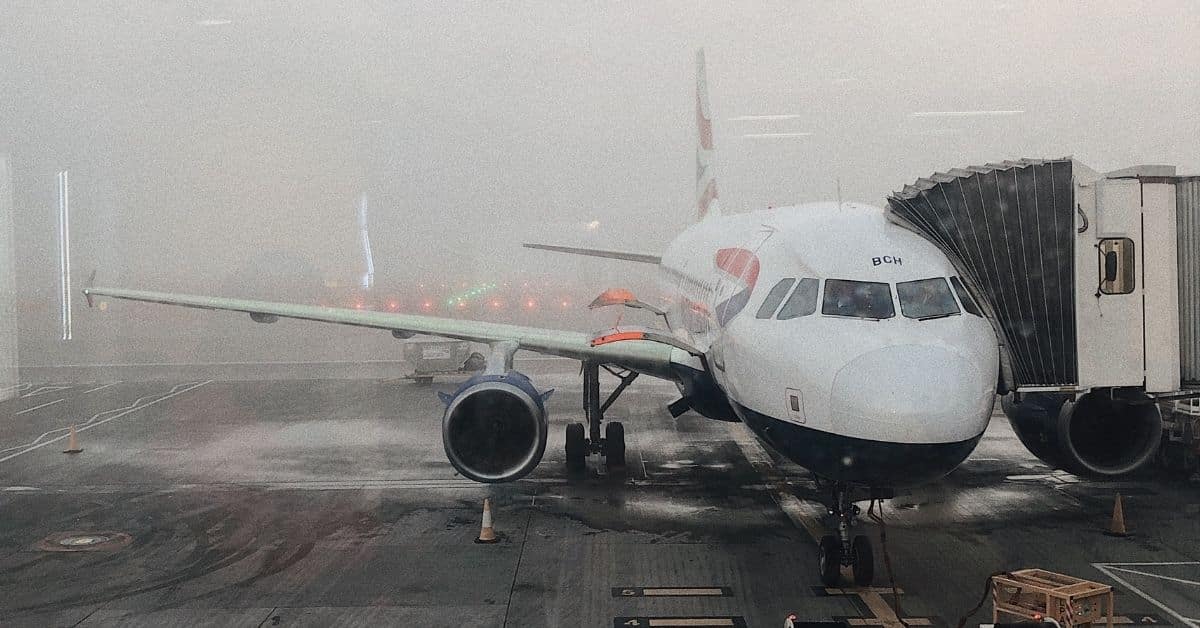During adverse weather conditions in which there is fog, aircraft may be landing and approaching an airport in which there is minimal visibility with the runway.
In modern commercial airliners, there is an Autoland feature that can be activated during low visibility, in which the aircraft effectively lands itself under the guidance of the autopilot. Operating an aircraft during low visibility requires what is referred to as Low Visibility Procedures (LVP).
Can Planes Land in Zero Visibility?
In the most extreme weather conditions with low visibility, aircraft may perform what is known as a Category III approach. A Category III approach enables an aircraft to fly the approach to the runway using the onboard automatic flight systems.
This system follows the glideslope and localizer on the specific Instrument Landing System (ILS) approach for the selected runway.
Although CAT III approaches allow for automatic approaches, there is a minimum requirement for some visual contact with the runway. This visual contact is outlined by what is known as the Decision Height (DH) and Runway Visual Range (RVR).
These values are different for every runway. Pilots will program these values into the aircraft’s flight system prior to commencing the approach. DH and RVR values can be found on the respective approach chart.
The purpose of DH and RVR is to determine the minimum height and visibility in which an aircraft can descend to safely to continue the approach to land.
If visibility is zero at the specific DH, a go-around must be performed by the flight crew. In some cases, there is a system called CAT IIIc, in which zero visibility landings can be performed.
However, this is not available in most airports around the world due to the high costs associated with the equipment required.
In most circumstances, a standard CAT III approach is more than sufficient for landing an aircraft. This is due to the low RVR and DH which the system can be capable of.
This is typically a DH of 100ft and an RVR of 200m. To assist with visual contact with the runway, airports are equipped with high-intensity runway lighting which outlines the runway approach lights and threshold to the pilots.
How often is CAT III Used?
Cat III is rarely used in most operating conditions. This is primarily due to the extreme weather conditions which must exist for it to be required.
However, some airports are more prone to low visibility conditions than others and as a result, CAT III approaches are more common.
A typical profile for airports that are susceptible to fog and low visibility conditions are high-elevation airports that are situated along a coastline. Although these are contributory factors, any airport can experience low visibility.
What Aircraft Can Use CAT III Autoland?
Most modern commercial aircraft are equipped with Category III approach capabilities. However, an aircraft must meet the requirements to maintain CAT III capabilities due to the precision required to operate Autoland systems.
These requirements vary based on aircraft type; however, they are typically based around the aircraft’s autopilot and autothrottle functionalities. These required systems must be operating correctly to allow for the aircraft to be certified as CAT III capable.
Autoland Touchdown and Rollout
Upon landing while using the Autoland system, the pilots can disengage the autopilot system once the aircraft is in the rollout phase (the deceleration of the aircraft on the runway). This transitions the control of the aircraft from the autopilot system to manual mode.
Autopilot and features such as Autoland enhance the flight safety of aircraft as they provide accuracy and precision in conditions which can be a heavy workload for the flight crew.
Aside from the safety aspect of these systems, they also reduce operational disruptions caused by weather. If an aircraft requires to be diverted to another airport, it is a logistical challenge for the airline, often leading to a loss of revenue and unhappy passengers.
As mentioned above, it is a challenge for airports to provide CAT III ILS equipment due to the high cost of implementing the required systems and maintenance.
As a result, only larger commercial airports are typically equipped with CAT III capability.
Read More:
Can A Plane Fly Without Wings?
Do Airplanes Ever Rest? | Aircraft Downtime

After visiting more than 60 countries, I have probably been on every type of plane there is and visited countless airports. I did my very first international solo trip to South Africa at the age of only 16 and haven’t really stopped traveling since.
Despite the adventurous travel itch, I do have a nerdy side as well – which is satisfied by writing about all things aviation “too boring” for my regular travel blog.
